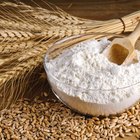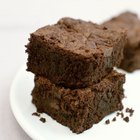SMarina/iStock/GettyImages
When trying to choose flour for your next baking project, a simple trip down the baking aisle can be confusing. While there are some similarities between cake flour and all-purpose flour, real differences exist as well, and each type is better suited for its intended purpose.
Similarities
All-purpose flour and cake flour both originate from milled wheat. Both are finely ground from the endosperm of the wheat kernel, which is the soft, starchy inner core of the kernel. Typically, both are bleached, and both contain significant amounts of both starch and protein.
Protein
The most significant factor between one type of flour and another is protein content. When you bake cakes or breads, you use a leavening agent such as yeast or baking powder to create small air bubbles, which provide a fluffy, soft, or spongy texture. The protein in flour forms gluten, which is a stretchy material that's flexible enough to allow air bubbles to expand, yet durable and stable enough to keep the gas trapped in and the structure of the cake or bread intact, and the higher the protein, the sturdier the cake or bread.
All-Purpose Flour
All-purpose flour is a ”jack-of-all-trades" flour that works well for everything from cupcakes to pastry dough. Its versatility lies in its mid-range protein content. Typically, all-purpose flour originates from a combination of hard winter wheat, which is 10 to 13 percent protein, and soft winter wheat, which is 6 to 10 percent protein. While the protein content differs among brands, the protein content generally ranges between 9 and 11 percent in all-purpose flour. This enables the gluten to be strong enough to stand up to slow yeast rising for breads, yet pliable enough to create a tender cake.
Cake Flour
Cake flour offers a finer grind than all-purpose flour. It also has a higher starch content and an especially low protein content, which generally ranges between 6 and 8 percent. The lower protein content creates weaker gluten structures, which are best for rapid-rising baked goods such as cakes and quick breads. Weaker gluten provides less resistance, which creates a finer, softer, more delicate crumb. Cake flour is bleached to make it more acidic, which improves its ability to hold water and sugar and helps prevent it from collapsing.
Substitution
In a pinch, you can substitute cake flour for all-purpose flour, and vice versa. For recipes that call for all-purpose flour, add two additional tablespoons of cake flour for every cup of all-purpose flour called for. For recipes that call for cake flour, decrease the amount of all-purpose flour for every cup of cake flour called for by two tablespoons.
Related Articles

Bread Flour vs. Cake Flour in Sponge ...
What Kind of Flour Do You Use for a ...

Can I Substitute Bleached for ...

Difference Between Red & White Wheat

What Kind of Flour to Use for Cupcakes?

Differences Between Bleached Flour & ...
Does Cake Flour Contain Baking Soda & ...
Can You Substitute Whole-Wheat Pastry ...

What Kind of Oil Do You Use in Brownie ...

Can You Make Dumplings With Corn Starch?

Lumpia vs. Egg Rolls

Can You Make Scones With Coconut Flour?

Do I Need a Special Cake Mix for ...

Whole Wheat Pastry: Flour Substitutions

How to Make Bread Chewy

What Is the Nutritional Value of Wheat?

Psyllium Husk & Gluten

Do You Still Need Baking Powder & Salt ...

How to Add Gluten to All-Purpose Flour
Is Unbleached Flour the Same as ...
References
Writer Bio
Jessica Martinez is a freelance writer from Clayton, North Carolina. As a homeschooling mom, she enjoys writing about education, child development and family issues. Martinez also enjoys researching and writing about subjects she loves: history, art, interior design, gardening and travel.